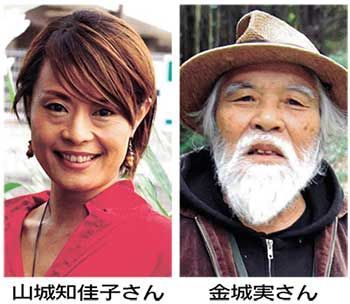Okinawan works at exhibit in Jeju, South Korea for the 70th anniversary of the Jeju Uprising depict the reality of the Battle of Okinawa and military base situation

Chikako Yamashiro Minoru Kinjo
April 18, 2018 Ryukyu Shimpo
The Jeju Museum of Art on Jeju Island off the southern coast of South Korea began their “Post Trauma Exhibit” March 31 to mark the 70th anniversary of the “Jeju Uprising,” a revolt that resulted in the deaths of tens of thousands of island residents at the hand of the South Korean military. The exhibit will run through June 24. The exhibit will display works from 10 artists both from South Korea and abroad with the themes of peace and human rights. The exhibit will feature two artists from Okinawa. The first is sculptor Minoru Kinjo ,79, who will be displaying seven works including a replica of “Han no hi” and “Fisherman McCulley’s Statue.” The second, filmmaker and artist Chikako Yamashiro, will have her film “Tsuchi no hito” shown on as many as three screens in the museum.
The Jeju Uprising occurred from 1948 all the way through 1954. Caused in part by the opposition to the formalization of the Korean peninsula being split into north and south halves, the revolt was for a long time seen as a, “communist uprising,” causing the survivors of the incident to face alienation.
The “Post Trauma Exhibit,” looks to re-interpret the historical meaning of the Jeju Uprising, with the goal of protecting human rights and creating a peaceful society. Kinjo’s “Han no Hi” depicts the brutal and severe reality of war; in the sculpture a Korean forced-laborer is being marched to his execution site with his hands tied behind his back by a Japanese soldier hitting him with the butt of his gun during the Battle of Okinawa. Yamashiro’s “Tsuchi no hito,” takes place in both Jeju and Okinawa, and uses an allegorical depiction of the strife in both regions as they grapple with their respective military bases.
Both Kinjo and Yamashiro attended the exhibit’s opening. Kinjo, based on his experience participating in the exhibit, proposed that for Okinawa Memorial Day, “I would like to devise a way to share these cultural messages such as showing ‘Tsuchi no hito’ at the Peace Memorial Park.” Yamashiro commented, “I felt the strength of will and depth of expression consoling the spirits of the dead. Artists from Taiwan, China, Vietnam and others participated. The exhibit made people reflect on their own country’s history and have conversations about not letting it fade from memory.”
(English translation by T&CT and Sam Grieb)
Previous Article:The National Museum of Nature and Science in Tokyo exhibits reconstructed face model of Paleolithic era person
Next Article:National Route 329 traffic halted for over 10 minutes to allow U.S. amphibious vehicles’ passage
[Similar Articles]
- Chikako Yamashiro receives prize at international film festival for Mud Man, which depicts the anguish of bearing military bases
- Okinawan and South Korean citizens hold peace symposium urging withdrawal of US troops
- Chikako Yamashiro receives Asian Art Award as young internationally rising artist
- Korean exchange students tour Okinawa to improve Japan-Korea relationships
- Yamashiro to address infringements on Okinawans’ rights at UN Human Rights Council in June
 Webcam(Kokusai Street)
Webcam(Kokusai Street)


